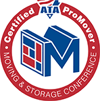Every office relocation is different, so you (along with your team) will need to decide what tasks to include in your specific project plan. The priority is to make sure every detail is covered within a set time-frame and budget.
Below are a few tips for a successful office move:
1. Decide if you will use full office relocation service movers before creating your project plan. If you decide to work with a full-service office mover, your mover (or move-management company) will handle the majority of the corporate relocation for you. This saves you and your team a lot of work and time! Once you select a relocation company, they should provide you with the detailed plan and help you manage the process.
2. No matter what, your office relocation plan must include the steps that your organization will take to select the best office mover. The plan will need to include a process to interview and hire a commercial mover with the experience, resources and manpower required for an efficient office move.3. Before signing a contract, make sure the moving company you hire has insurance and get them to fax you a copy of it.
4. Inform employees of the upcoming move as early as possible. If you are making a long-distance relocation, discuss relocation packages. Keep employees informed throughout the process via regular emails, posted notices and announcements during company meetings.
5. Determine the required space needed in the new office. Plan for future growth if needed.
6. Select the new office location and negotiate a lease. Decide in advance the type and length of lease you need.
7. Work with an office space planner on design and build out. Know the dimensions of the new space. With this information, you and your office relocation company can map out desk and office space.
8. Work with your IT department in planning the new office infrastructure. We will have a series of blog posts about relocating your IT department.
9. An office relocation presents a good time to replace outdated equipment and furnishings. Perform an inventory and decide what items will be moved or replaced. Also decide how you will dispose of the outdated office furniture and equipment.
10. Update all marketing collateral including the company website and online citations, brochures, stationary, business cards and also determine the ones that will require address changes.
11. Notify customers and vendors about the upcoming relocation. Take advantage of this opportunity to communicate with your current, former and prospective customers multiple times throughout the relocation process. Announce the upcoming move. If you are relocating due to company growth, proudly tell customers and vendors. Later send an update about how well plans for the relocation are going, and then announce completion of the move.
Here's a simple checklist to make sure nothing gets left behind or overlooked:
- Desk empty?
- Supply cabinets cleared?
- File cabinets cleared?
- File drawers locked?
- Wall items taken down?
- Breakable items properly packed?
- Computers and other machines disconnected?
- "Do Not Move" tags placed?
- Liquids drained from equipment?
- Everything labeled?
- Have a set of spare keys available.
- Make sure that your Internet connection is ready to go and that the phones and fax machines are working.
- Make sure the electricity works.
- Make sure the bathrooms work.
- Don't forget to throw away (or use as scratch paper) any old stationary (or business cards) that has your old address on it and create new stationary with the new address on it.
Our best advice - Always remember to plan your move as early as possible!
For local business relocations, planning is done six months in advance while for large commercial, it takes up to two years of planning.






.png)





